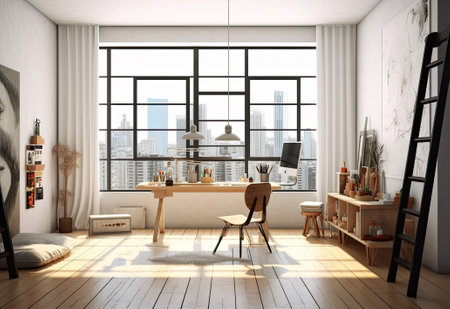Why LED Lighting Matters for Your Home Office
When setting up your home office, lighting is often overlooked, but it plays a crucial role in your daily comfort and productivity. Choosing the right lighting can make a significant difference, especially if you work remotely for long hours. LED lights have become the top choice for home offices across the United States because of their unique advantages over traditional bulbs.
One major benefit is energy efficiency. LEDs use significantly less power than incandescent or fluorescent options, helping you save on electricity bills while reducing your carbon footprint. This makes them an eco-friendly and cost-effective solution for any workspace.
Another key advantage is reduced eye strain. With features like adjustable brightness and color temperature, LED lights allow you to create a personalized lighting environment that minimizes glare and prevents fatigue during extended periods of screen time. This is especially important in home offices where ambient daylight may be limited or inconsistent.
Most importantly, the right LED lighting can improve productivity. Studies show that well-lit workspaces promote focus and concentration, making it easier to stay engaged with tasks throughout the day. By investing in quality LED lights designed for office use, you’re creating an environment that supports both your well-being and your professional goals as a remote worker.
2. Key Features to Consider When Choosing LED Lights
When outfitting your home office with the best LED lights, it’s important to pay attention to several key features that directly impact comfort, productivity, and energy efficiency. Below, we break down the essential factors you should consider before making a purchase.
Color Temperature
The color temperature of your LED lights can significantly affect your mood and focus. For home offices, aim for lighting in the 4000K–5000K range, which delivers a crisp, daylight-like tone ideal for concentration. Warmer tones (below 3500K) may create a cozy atmosphere but could make you feel drowsy during work hours.
| Color Temperature (Kelvin) | Light Appearance | Best For |
|---|---|---|
| 2700K–3500K | Warm White | Relaxed spaces |
| 4000K–5000K | Cool White/Daylight | Home offices, workspaces |
Brightness (Lumens)
The brightness level, measured in lumens, should match the size and function of your workspace. Generally, a home office requires around 300–500 lumens per square meter. Adjustable brightness is a plus, allowing you to tailor light levels throughout the day.
| Lumens Needed | Room Size (sq ft) |
|---|---|
| 1500–3000 lm | 50–100 sq ft |
| 3000–6000 lm | 100–200 sq ft |
Adjustability and Flexibility
A quality LED fixture should offer adjustability—both in brightness and positioning. Look for dimmable options or fixtures with adjustable arms and heads. This flexibility helps reduce eye strain by allowing you to customize lighting angles and intensity based on the task at hand.
Smart Home Compatibility
If you use smart home systems like Amazon Alexa, Google Home, or Apple HomeKit, consider LED lights that integrate seamlessly with these platforms. Smart LEDs allow voice-activated controls, remote scheduling, and scene customization—all features that enhance convenience and efficiency in your home office.
Main Considerations at a Glance:
| Feature | Why It Matters |
|---|---|
| Color Temperature | Affects focus and mood |
| Brightness (Lumens) | Ensures adequate lighting for tasks |
| Adjustability | Reduces eye strain; customizable lighting experience |
| Smart Compatibility | Adds convenience with automation and voice control |
Your Takeaway:
Selecting the right LED lights for your home office means balancing these key features to create a comfortable, productive environment tailored to your specific needs.
![]()
3. Types of LED Lights for Home Offices
Choosing the right LED lighting can transform your home office into a comfortable and productive workspace. Below is a breakdown of popular LED lighting options, each suited for different needs and preferences in a home office environment.
Desk Lamps
LED desk lamps are a staple for focused task lighting. They provide direct illumination, ideal for reading, writing, or working on detailed tasks at your workstation. Look for adjustable arms and color temperature controls—features found in models like the BenQ e-Reading LED Desk Lamp or the TaoTronics LED Desk Lamp, both offering flexibility to reduce eye strain during long work hours.
Overhead Fixtures
For general ambient lighting, overhead LED fixtures are essential. Flush-mount ceiling lights or modern pendant fixtures ensure even light distribution throughout the room. Products like the Lithonia Lighting LED Flush Mount deliver energy efficiency and a clean look suitable for most American home offices. Consider dimmable fixtures to tailor brightness as needed throughout the day.
Strip Lights
LED strip lights are versatile and can be used to enhance under-cabinet areas, bookshelves, or behind monitors for subtle backlighting. Options such as the Govee Smart LED Light Strips allow customizable color settings and remote control via smartphone apps—perfect for adding a personal touch or reducing screen glare during video calls.
Accent Lighting
Accent lighting adds character and depth to your workspace while highlighting artwork or architectural features. Small LED spotlights or puck lights can be installed on shelves or display cases. The Philips Hue White and Color Ambiance range enables smart control and mood customization, blending seamlessly with modern home office decor.
Choosing What Works Best
The best setup often combines multiple types: a bright overhead fixture for general tasks, a focused desk lamp for close work, strip lights to reduce eye strain, and accent lighting to create a welcoming atmosphere. Evaluate your workspace’s size, layout, and natural light sources when selecting your LED solutions to ensure both functionality and style in your home office.
4. Top LED Lighting Picks for Home Offices
Choosing the right LED lighting can significantly improve your productivity and comfort while working from home. Here’s a curated selection of highly-rated LED lights available in the U.S., each with their own pros, cons, and ideal use cases to help you find the best fit for your workspace.
| Product | Type | Pros | Cons | Best For |
|---|---|---|---|---|
| BenQ e-Reading LED Desk Lamp | Desk Lamp | Wide coverage, adjustable brightness & color temperature, flicker-free | Higher price point, large footprint | Large desks, multiple monitors, extended work sessions |
| Philips Hue White Ambiance Light Bar | Smart Light Bar | Voice control, app integration, customizable color temperature | Requires Hue Bridge for full features, higher cost | Tech-savvy users, those wanting dynamic lighting setups |
| TaoTronics LED Desk Lamp TT-DL16 | Sleek Desk Lamp | USB charging port, adjustable arm, affordable price | Lacks advanced smart features, smaller light spread | Compact desks, budget-conscious buyers, task lighting |
| LIFX Color A19 Smart Bulb | Smart Bulb | No hub required, millions of colors, energy efficient | No physical controls on bulb, app-dependent setup | Dimmable overhead fixtures, mood lighting adjustments |
| Aukey Table Lamp Touch Sensor LT-T6 | Table Lamp (Touch) | Touch controls, color-changing options, portable design | No smart home integration, limited brightness for larger spaces | Side tables, accent lighting, casual workstations |
| Cree Lighting Connected Max Tunable White LED Bulb | Tunable Smart Bulb | Easily adjustable color temperature via app or voice assistant, affordable pricing | Might require compatible hub for advanced features, standard bulb appearance only | Main room lighting, renters seeking easy upgrades |
User Tips for Selecting Your LED Lights
- Assess Your Space: Consider whether you need focused desk lighting or ambient room illumination.
- Think About Controls: Decide if you prefer manual controls or smart home integration via voice assistants like Alexa or Google Assistant.
- Balance Budget and Features: Prioritize essential functions—such as adjustable brightness or color temperature—based on your daily work needs.
The Bottom Line on Top Picks
No matter your preferences or budget, there’s an ideal LED solution for every home office. By matching key features to your specific work habits and space requirements, you can create a productive and comfortable environment that supports your best workday after day.
5. Tips for Setting Up Optimal Home Office Lighting
Creating a productive and comfortable home office starts with smart lighting choices. Here are some practical tips and American-style hacks for positioning and layering LED lights to minimize glare, boost focus, and create a workspace that truly works for you.
Layer Your Lighting
Don’t rely on a single overhead fixture. Combine ambient, task, and accent lighting to balance brightness throughout your space. Use an LED ceiling light for general illumination, a desk lamp with adjustable color temperature for focused tasks, and wall sconces or floor lamps to fill in shadows and add warmth.
Position Your Desk Wisely
If possible, place your desk near a window to take advantage of natural light without letting direct sunlight hit your computer screen. This reduces eye strain and gives your home office an inviting feel. Supplement with LED lighting on cloudy days or during evening hours.
Avoid Glare and Reflections
Set up your monitor perpendicular to windows and away from harsh overhead lights. Choose LED desk lamps with diffusers or frosted shades to soften the light and prevent distracting glares on screens or glossy surfaces.
Customize Light Temperature
Look for LEDs with adjustable color temperatures (measured in Kelvins). For most Americans working from home, 4000K–5000K offers a crisp, energizing daylight effect—perfect for staying alert during long Zoom meetings. Warmer tones around 3000K can be used in the evening to help you wind down after work.
Add Smart Controls
Upgrade to smart LED bulbs or plugs so you can adjust brightness with your voice or smartphone—no more fumbling behind furniture. Set routines that automatically brighten your space in the morning and dim it at night to support healthy work habits.
Pro Tip: Light What Matters
Highlight important zones—like your reading nook or reference shelves—with focused LED spotlights or under-cabinet strips. These American home office hacks not only enhance functionality but also give your workspace a custom look without breaking the bank.
6. Maintaining and Upgrading Your LED Home Office Lighting
How to Care for Your LED Lights
Proper maintenance is key to ensuring your LED lights deliver optimal performance in your home office. Regularly dust the fixtures and bulbs using a soft, dry cloth to prevent debris buildup, which can reduce brightness over time. Avoid using harsh chemicals or abrasive materials that may damage the light’s surface or circuitry. Additionally, check for any loose connections or flickering lights—these can be early signs of wear or installation issues that should be addressed promptly.
When to Upgrade Your LED Lighting
While LEDs are known for their longevity, they don’t last forever. If you notice a significant drop in brightness, color shifts, or persistent flickering even after cleaning and checking connections, it might be time to upgrade. Advances in LED technology happen quickly; newer models often offer better energy efficiency, improved color rendering, and smart features like voice controls or scheduling that can enhance productivity in your workspace. Consider upgrading every 5–7 years or when your current lighting no longer meets your needs.
Sustainable Disposal Tips Aligned with American Environmental Guidelines
Disposing of old LED bulbs responsibly is crucial for minimizing environmental impact. In the United States, LEDs are generally considered non-hazardous waste but should not be thrown in the regular trash due to their electronic components. Check with your local recycling center or municipal waste program—many communities have special e-waste collection days or drop-off sites. Retailers like Home Depot and Lowe’s also offer bulb recycling programs nationwide. Always place used LEDs in a sealed bag before transport to prevent breakage and follow EPA recommendations for sustainable disposal.
Summary
Maintaining and upgrading your LED home office lighting is essential for creating a productive and eco-friendly work environment. With proper care, timely upgrades, and responsible disposal practices following U.S. guidelines, you can enjoy efficient illumination while supporting sustainability at home.


